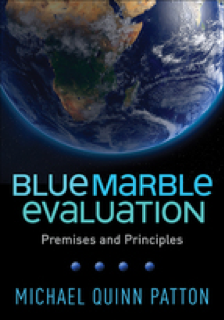I am Michael Quinn Patton, founder and director of Utilization-Focused Evaluation, and author of Blue Marble Evaluation: Premises and Principles. In 1972, the first photo of the whole Earth from space became known as The Blue Marble, the home of all humans, seen for the first time without borders or boundaries, a whole Earth perspective.

We humans are using our planet’s resources, and polluting and warming it, in ways that are unsustainable. Blue Marble evaluators enter the fray by providing ongoing feedback for adaptation and enhanced sustainability. The Blue Marble perspective means looking beyond nation-state boundaries and across sector and issue silos to connect the global and local, the human and ecological, the macro and the micro, the personal and societal, and the individual with humanity. Blue Marble Evaluation uses evaluative thinking and diverse methods to engage those trying to bring about global systems transformation. The first Blue Marble Evaluation principle expresses the importance of thinking globally, acting locally, and evaluating the interactions.
Hot Tip: Apply whole Earth, big picture thinking to all aspects of systems change and evaluation.
Hot Tip: Integrate complex interconnections across levels, connecting the local and personal with the global, and vice versa.
Hot Tip. A high-level function of evaluation is synthesis. Systems thinking supports synthesis by directing attention to interconnections, interrelationships, and interdependencies
Lessons Learned: Learning to see interconnections takes practice.
Practice: Here’s a chance to practice distinguishing the global signal relevant to you and yours as distinct from the worldwide chaos of noise, misinformation, and fake news.
How are these 22 global phenomena related to each other, to your local context, to you, and, ultimately, to our collective future? What are the interconnections, interrelationships, and interdependencies?
1. Coronavirus pandemic
2. Refugee crisis (50 million, since World War II)
3. Devastating Australian wildfires.
4. Melting glaciers in the Arctic and Antarctic poles
5. Widespread locust devastation in eastern and southern Africa.
6. The political crisis in Venezuela.
7. The world’s richest 1% with more than twice as much wealth as 6.9 billion people combined. (Oxfam International)
8. Two-thirds of everything we take from the Earth becomes waste. (National Geographic)
9. Increased cyber-terrorism
10. Pollution of land, air, and oceans.
11. Massive ecosystem loss in the Amazon.
12. More than 800 million people chronically undernourished.
13. Increases in white supremacy and nationalist movements
14. Widespread plastic contamination of oceans, lakes, and rivers
15. Massive species extinction (WWF)
16. More severe weather and intense storms.
17. Major water shortages affecting millions.
18. The world population increased from 1 billion in 1800 to 7.7 billion today, increasing by 90 million each year.
19. The point of no return on global warming is around 2030: No country is meetings its carbon reduction target. (United Nations)
20. Increased threat from nuclear weapons. (Atomic Scientists)
21. Global economic turbulence
22. Add your own trend to the list
Think systemically. What are the interconnections, interrelationships, and interdependencies among these trends?
Think globally, act locally, and evaluate the interactions.
Rad Resource: See the book Blue Marble Evaluation: Premises and Principles

Rad Resource: Blue Marble Evaluation website
The American Evaluation Association is celebrating Environmental Program Evaluation TIG Week with our colleagues in the Environmental Program Evaluation Topical Interest Group. The contributions all this week to aea365 come from our EPE TIG members. Do you have questions, concerns, kudos, or content to extend this aea365 contribution? Please add them in the comments section for this post on the aea365 webpage so that we may enrich our community of practice. Would you like to submit an aea365 Tip? Please send a note of interest to aea365@eval.org. aea365 is sponsored by the American Evaluation Association and provides a Tip-a-Day by and for evaluators.
